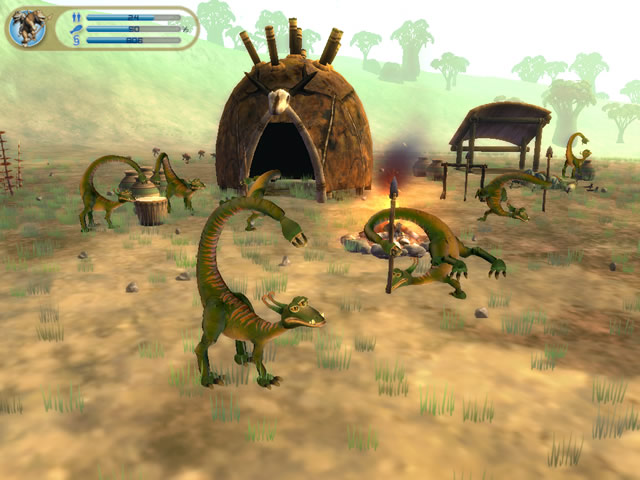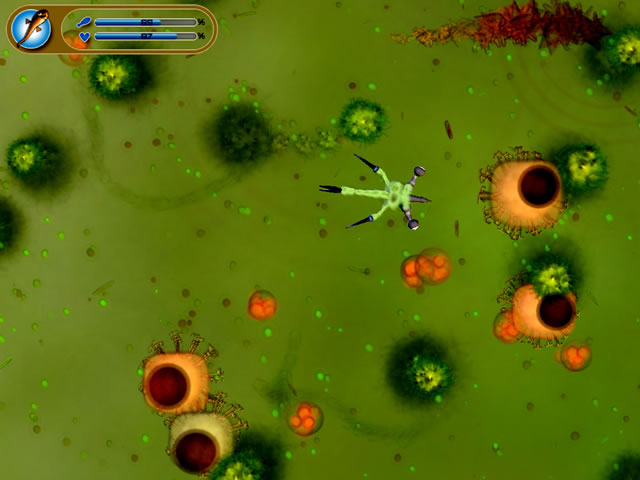Life, the Universe, and Everything.
For all its pomp and circumstance, often the best that E3 has to offer isn’t found plastered on gigantic billboards or crammed into wall-sized FMV reels. It isn’t found in the pre-show press conferences or at the end of a two-hour theater line. It certainly isn’t found scrawled across a booth babe’s tiny tank-top, although we shamefully admit to double-checking that fact a few times. We’re nothing if not thorough.
In fact, the best that E3 2005 had to offer was unceremoniously squashed behind the enormous EA booth, at the back of a pleasantly air-conditioned meeting room that apparently only about fifty people managed to barge their way into. I was lucky enough to be one such barger, and while my dislocated shoulder might never be the same, it was a small price to pay. After all, how often do you get to see the future?
Lower your hand, Mr. McFly. The future I’m talking about comes from the mind of Will Wright, the lord and master of the “Sim” series. Apparently it wasn’t enough for Mr. Wright to make thirty billion dollars with The Sims, because his current endeavor, Spore, makes the former look like a tea party. Whereas that terrific game simulated the social aspects of life, Spore focuses on, well, just about everything else.
Spore begins, of all places, in a pile of goo. You start as a two-dimensional single-cell organism whose sole capacity is to “eat” smaller floating bits. This eventually leads to the first evolutionary step – the ability to attack things. Stick a horn on your amoebic bag and watch it take down bigger floaty bits than before, or add some creepy hair-like fins to increase its speed when fleeing predators.
Eventually, you’ll lay an egg, which takes your thing from the tide pool to the swamp and triggers perhaps the coolest creature editing device seen outside the iron gates of Pixar itself. You can manipulate your creature’s skeleton by literally shaping a ball of clay. Sculpt any shape you like, add or subtract limbs, give it googly eyes or a gaping maw – whatever your inner Dr. Frankenstein desires. Plant eater? Meat eater? Everything eater? This is the basic premise for your beast as it evolves over time, the blueprint of its life.
As you wail on other lifeforms, you’ll gain points to spend on upgrading new parts. Soon you’ll lay another egg, rock the editor, and advance up the ladder to the next phase: walking.
Using “procedural animation,” Spore animates your creature based entirely on physics, meaning it doesn’t require any hand animators whatsoever. If you build tiny, skinny legs, your creature will wobble along slowly, whereas if you build fat, strong thighs, your creature will cover ground quickly. I saw a handful of bizarre examples, from Will’s own three-legged beastie (see screenshots) to a two-faced spidery-thing with twelve legs, and all managed to move appropriately, if that’s the right word.
During this walking phase Spore moves from a single-creature workshop into a much more complex experience. As your creature learns how to walk on solid ground, it will encounter a variety of other lifeforms, all of which are actually created by other users. Every player’s creature data is compressed into a tiny file and uploaded to the game’s server network, which then sends that data back to other players’ games. In other words, your world is populated by other people’s creatures without actually being massively multiplayer. You don’t play with anyone else, but you share each other’s content. It’s a daring design move that might be the best example of what “user-created content” can mean.
 As your freak wanders the land killing smaller things and avoiding giant creepy ones, it will eventually find a mate and lay another egg, which prompts another bout with the editor, this time allowing you to give it nasty new weapons and better parts. This also moves the game into a “tribal” period. You’ll start to toy with the foundations of culture by introducing actual weapons into the mix or perhaps focusing more on art and technology by giving your crew some drums. Get down with your seven arms.
As your freak wanders the land killing smaller things and avoiding giant creepy ones, it will eventually find a mate and lay another egg, which prompts another bout with the editor, this time allowing you to give it nasty new weapons and better parts. This also moves the game into a “tribal” period. You’ll start to toy with the foundations of culture by introducing actual weapons into the mix or perhaps focusing more on art and technology by giving your crew some drums. Get down with your seven arms.
What starts off as a small gathering of your beasts will eventually turn into a full-fledged city builder, a pared-down version of SimCity. The look and feel of your buildings will mimic the look and feel of your creature; this was demonstrated via two entirely different cities, one made of brutal, pointy metal, another of happy, Smurfy mushrooms. You’ll soon be able to design vehicles as well, navigating the entire planet with tanks, planes and boats, setting up trade routes or plundering other tribes.
As if the transition from bacteria to architect wasn’t crazy enough, Spore takes another giant leap for game-kind as it allows you to enter space. Once you build a UFO, you’ll be able to actually cruise around the whole planet, terraforming the environment and even abducting other life forms. Pull out even further and you’ll witness the solar system. Take some of your beasts to colonize another world, but be careful that it’s ripe for life. If it’s uninhabitable, you can use some fancy carbon canisters to change the climate, creating forests out of thin air. Alternately, you can slap down a giant biodome and fulfill your fantasy of living in a bubble.
You can then pull out even further to the mind-boggling entirety of the galaxy, where you can attempt to communicate with strange alien races; this was demonstrated via Spore‘s version of a certain famous musical scene. Go to war or make new friends. Land and colonize or blow an offending planet into space dust. It’s your universe…sort of. Every world out there is actually made by another user, remember, albeit just a copy of their data. Considering it isn’t actually online, Spore looks to revolutionize the way we play with one another.
It also defies description. If you think this preview is hard to follow, just imagine what my crazy notes look like. Spore is one of the most ambitious games we’ve ever seen, a total monster of an undertaking with a limitless upside. Of course, life is filled with questions and currently many of ours (what’s the interface like? how does it all connect?) remain unanswered. We’ll just have to believe in the evolutionary process and let this beast walk before it learns to fly in 2007. Count on another peek into the vastness of creation along the way.







